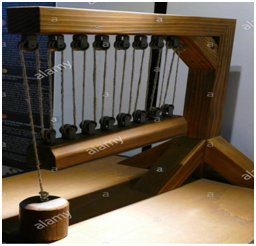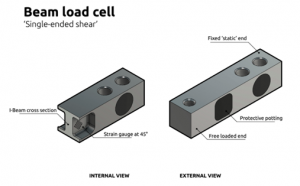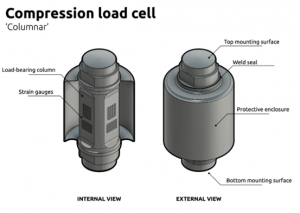Aகலத்தை ஏற்றுஒரு குறிப்பிட்ட வகையான டிரான்ஸ்டியூசர் அல்லது சென்சார் ஆகும், இது சக்தியை அளவிடக்கூடிய மின் வெளியீடாக மாற்றுகிறது. உங்கள் வழக்கமான சுமை செல் சாதனம் ஒரு கோதுமைக்கல் பாலம் உள்ளமைவில் நான்கு திரிபு அளவீடுகளைக் கொண்டுள்ளது. ஒரு தொழில்துறை அளவில் இந்த மாற்றம் ஒரு சுமையை அனலாக் மின் சமிக்ஞையாக மாற்றுவதைக் கொண்டுள்ளது.
லியோனார்டோ டா வின்சி, அறியப்படாத எடைகளை சமநிலைப்படுத்தவும் தீர்மானிக்கவும் ஒரு இயந்திர நெம்புகோலில் அளவீடு செய்யப்பட்ட எதிர் எடைகளின் நிலைகளைப் பயன்படுத்தினார். அவரது வடிவமைப்புகளின் மாறுபாடு, பல நெம்புகோல்களைப் பயன்படுத்தியது, ஒவ்வொன்றும் வெவ்வேறு நீளம் மற்றும் ஒரு நிலையான எடையுடன் சமநிலைப்படுத்தப்பட்டது. தொழில்துறை எடையிடும் பயன்பாடுகளுக்கான இயந்திர நெம்புகோல்களை ஹைட்ராலிக் மற்றும் எலக்ட்ரானிக் ஸ்ட்ரெய்ன் கேஜ் சுமை செல்கள் மாற்றுவதற்கு முன்பு, இந்த இயந்திர நெம்புகோல் செதில்கள் பரவலாகப் பயன்படுத்தப்பட்டன. அவை மாத்திரைகள் முதல் ரயில் பெட்டிகள் வரை அனைத்தையும் எடைபோடப் பயன்படுத்தப்பட்டன, மேலும் அவை சரியாக அளவீடு செய்யப்பட்டு பராமரிக்கப்பட்டால் துல்லியமாகவும் நம்பகத்தன்மையுடனும் அவ்வாறு செய்தன. அவை எடை சமநிலைப்படுத்தும் பொறிமுறையைப் பயன்படுத்துதல் அல்லது இயந்திர நெம்புகோல்களால் உருவாக்கப்பட்ட விசையைக் கண்டறிதல் ஆகியவற்றை உள்ளடக்கியது. ஆரம்பகால, முன்-ஸ்ட்ரெய்ன் கேஜ் விசை உணரிகளில் ஹைட்ராலிக் மற்றும் நியூமேடிக் வடிவமைப்புகள் அடங்கும்.
1843 ஆம் ஆண்டில், பிரிட்டிஷ் இயற்பியலாளர் சார்லஸ் வீட்ஸ்டோன் மின் எதிர்ப்பை அளவிடக்கூடிய ஒரு பால சுற்று ஒன்றை உருவாக்கினார். வீட்ஸ்டோன் பால சுற்று, திரிபு அளவீடுகளில் ஏற்படும் எதிர்ப்பு மாற்றங்களை அளவிடுவதற்கு ஏற்றது. முதல் பிணைக்கப்பட்ட எதிர்ப்பு கம்பி திரிபு அளவீடு 1940 களில் உருவாக்கப்பட்டது என்றாலும், நவீன மின்னணுவியல் கண்டுபிடிக்கப்பட்ட பிறகுதான் புதிய தொழில்நுட்பம் தொழில்நுட்ப ரீதியாகவும் பொருளாதார ரீதியாகவும் சாத்தியமானது. இருப்பினும், அந்த நேரத்திலிருந்து, திரிபு அளவீடுகள் இயந்திர அளவிலான கூறுகளாகவும், தனித்த சுமை செல்களிலும் பெருகிவிட்டன. இன்று, துல்லியமான இயந்திர சமநிலைகள் இன்னும் பயன்படுத்தப்படும் சில ஆய்வகங்களைத் தவிர, திரிபு அளவீட்டு சுமை செல்கள் எடையிடும் தொழிலில் ஆதிக்கம் செலுத்துகின்றன. உள்ளார்ந்த பாதுகாப்பு மற்றும் சுகாதாரம் விரும்பும் இடங்களில் நியூமேடிக் சுமை செல்கள் சில நேரங்களில் பயன்படுத்தப்படுகின்றன, மேலும் ஹைட்ராலிக் சுமை செல்கள் தொலைதூர இடங்களில் கருதப்படுகின்றன, ஏனெனில் அவற்றுக்கு மின்சாரம் தேவையில்லை. திரிபு அளவீட்டு சுமை செல்கள் 0.03% முதல் 0.25% வரை முழு அளவிலிருந்து துல்லியத்தை வழங்குகின்றன மற்றும் கிட்டத்தட்ட அனைத்து தொழில்துறை பயன்பாடுகளுக்கும் ஏற்றவை.
இது எப்படி வேலை செய்கிறது?
சுமை செல் வடிவமைப்புகள் உருவாக்கப்படும் வெளியீட்டு சமிக்ஞையின் வகையைப் பொறுத்து (நியூமேடிக், ஹைட்ராலிக், மின்சாரம்) அல்லது அவை எடையைக் கண்டறியும் விதத்தைப் பொறுத்து (அமுக்கம், பதற்றம் அல்லது வெட்டு) வகைப்படுத்தப்படுகின்றன.ஹைட்ராலிக்சுமை செல்கள் என்பவை விசை-சமநிலை சாதனங்கள் ஆகும், அவை உள் நிரப்பும் திரவத்தின் அழுத்தத்தில் ஏற்படும் மாற்றமாக எடையை அளவிடுகின்றன.நியூமேடிக்சுமை செல்கள் விசை-சமநிலை கொள்கையின் அடிப்படையிலும் இயங்குகின்றன. இந்த சாதனங்கள் பல தணிப்பான்களைப் பயன்படுத்துகின்றன.
ஒரு ஹைட்ராலிக் சாதனத்தை விட அதிக துல்லியத்தை வழங்க அறைகள்.ஸ்ட்ரெய்ன்-கேஜ்சுமை செல்கள் அவற்றின் மீது செயல்படும் சுமையை மின் சமிக்ஞைகளாக மாற்றுகின்றன. அளவீடுகள் தாங்களாகவே ஒரு கற்றை அல்லது கட்டமைப்பு உறுப்பினருடன் பிணைக்கப்பட்டுள்ளன, அவை எடை பயன்படுத்தப்படும்போது சிதைந்துவிடும்.
இடுகை நேரம்: மே-06-2021




